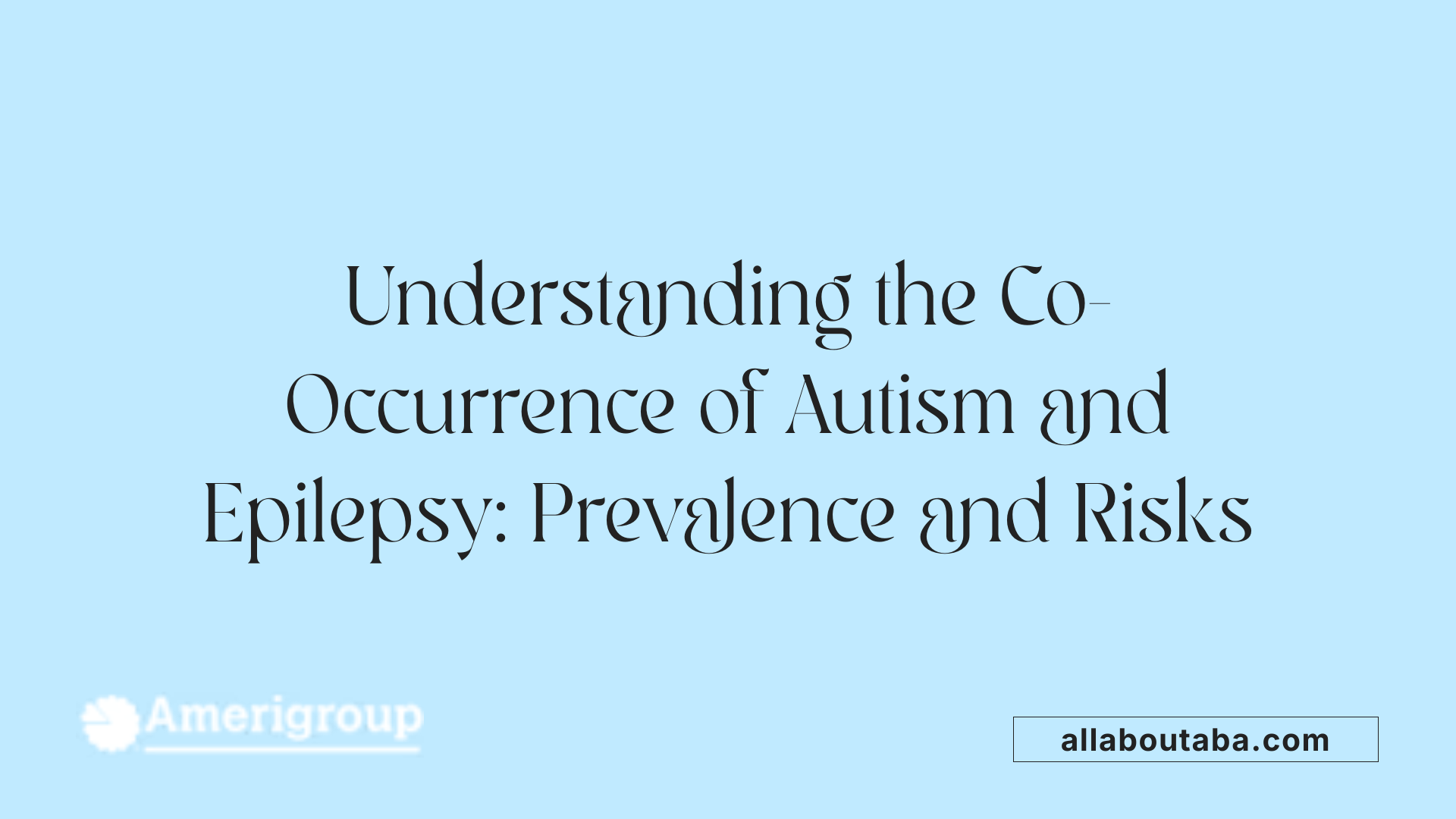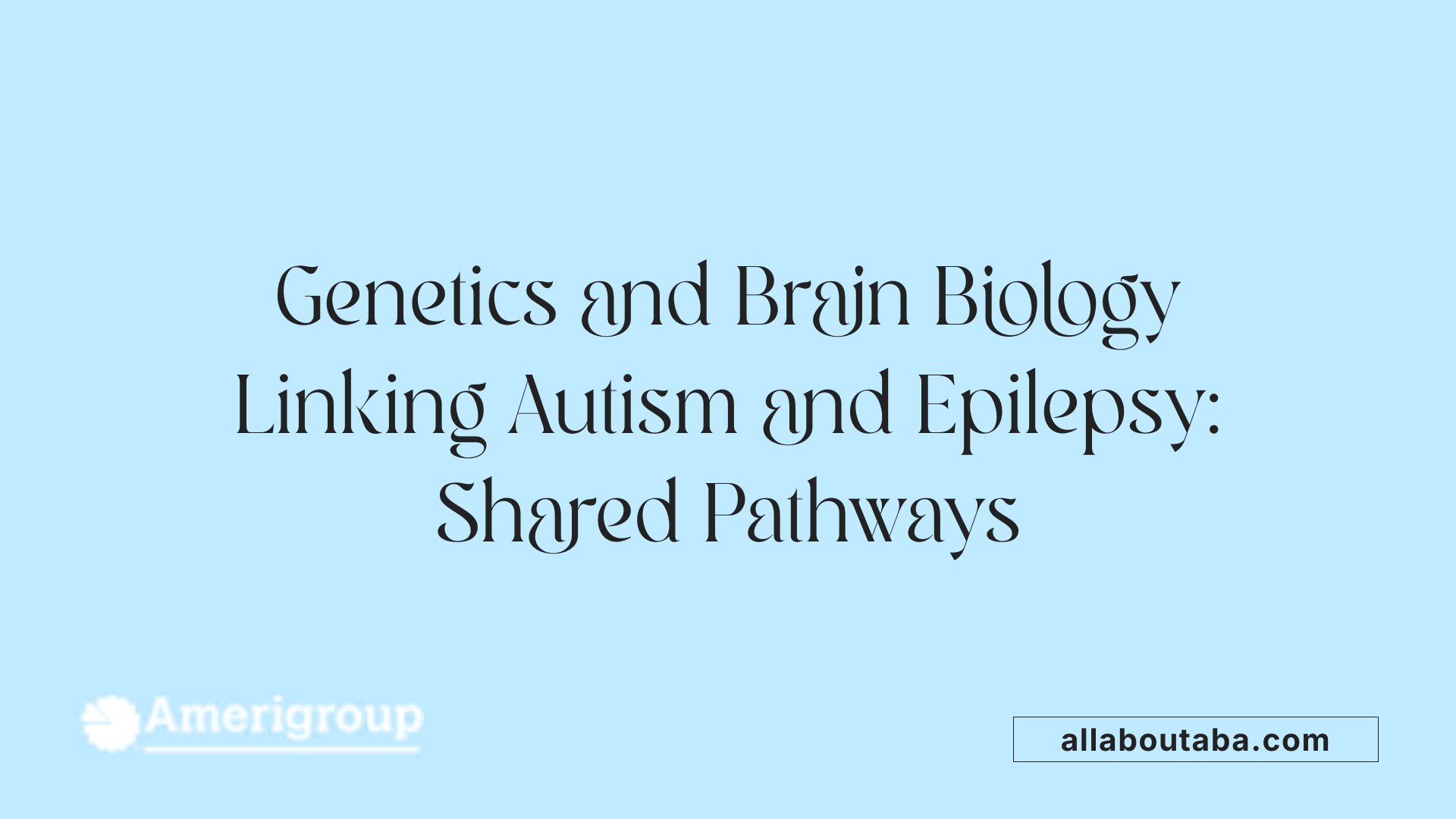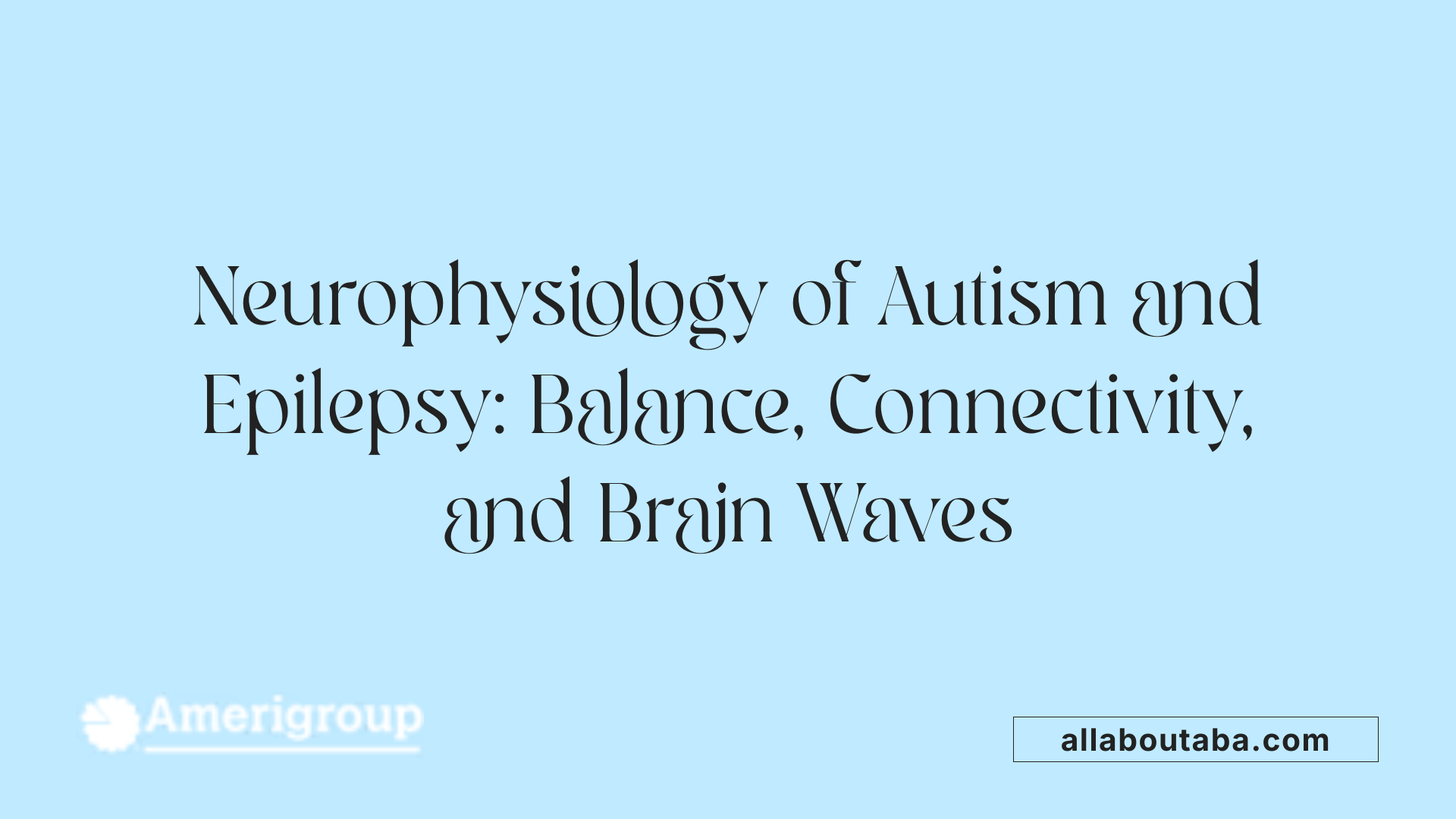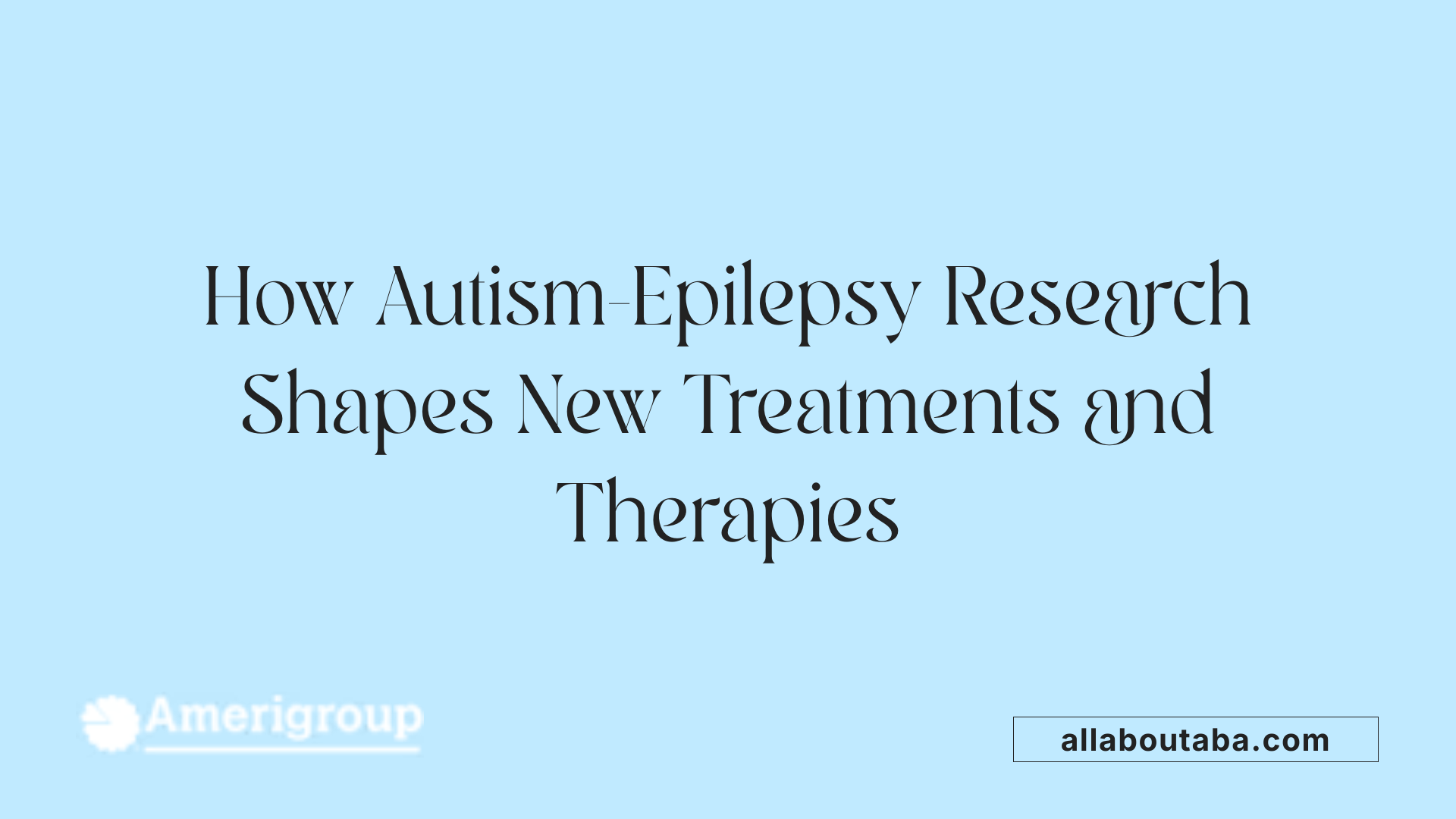The Connection Between Autism And Epilepsy
Understanding the Overlapping Neurodevelopmental Challenges
Autism Spectrum Disorder (ASD) and epilepsy are two complex neurological conditions that frequently coexist, presenting unique challenges to diagnosis, management, and therapy. Recent research highlights a profound genetic and neurobiological overlap between these disorders, revealing shared pathways and mechanisms. This article delves into the multifaceted connection between autism and epilepsy, emphasizing the implications for therapeutic strategies including behavioral analysis treatment approaches.
Prevalence and Bidirectional Relationship of Autism and Epilepsy

What is the prevalence of epilepsy among individuals with autism?
Epilepsy and epileptiform abnormalities frequently occur in individuals with autism spectrum disorder (ASD). Studies report that the incidence of epilepsy in people with ASD ranges widely, approximately from 23.6% up to 60.8%. This wide range underscores a significant common comorbidity between the two conditions.
Are people with epilepsy more likely to be diagnosed with autism?
Yes, individuals diagnosed with epilepsy are more likely to also have autism spectrum disorder compared to the general population. This elevated likelihood highlights a strong association between epilepsy and ASD beyond mere coincidence.
How does the relationship between autism and epilepsy manifest?
The relationship between autism and epilepsy is bidirectional. Children with ASD have an increased risk of developing epilepsy. Conversely, the presence of epilepsy in individuals with autism is associated with more pronounced cognitive and behavioral challenges. In particular, seizures and epileptiform activity in ASD are linked to worsened neurodevelopmental outcomes, suggesting that epilepsy can exacerbate ASD-related difficulties.
These findings emphasize the need for comprehensive clinical monitoring in autistic individuals for signs of epilepsy, and vice versa, to better support the overlapping aspects of these neurological conditions.
Genetic and Neurobiological Overlaps Between Autism Spectrum Disorder and Epileptic Encephalopathies

How Are Monogenic Epileptic Encephalopathies Related to Autism Spectrum Disorder?
Monogenic epileptic encephalopathies (EE) are severe brain disorders caused by mutations in a single gene and are often associated with developmental issues including autism spectrum disorder (ASD). Infantile spasms, a type of EE, show a strong link to ASD development. While the direct impact of seizures on neurobehavioral deficits is still debated, research increasingly points to genetic mutations as the main drivers linking epilepsy and ASD.
Which Genes Are Known to Be Involved in Both ASD and Epileptic Encephalopathies?
Several genes influence both conditions by affecting brain processes such as synaptic transmission and neurotransmitter systems. Notably, genes like SCN2A, CDKL5, SCN1A, and SLC6A1 have been identified as contributors to epileptic encephalopathies and ASD. SCN2A, in particular, has strong evidence tying its variants to neurodevelopmental challenges including autism features. Additionally, genes involved in GABA signaling—such as GABRA5, GABRB3, and GABRG3—play a crucial role by disrupting the brain's balance of excitatory and inhibitory signaling, a common pathway implicated in both disorders.
What Role Do Genetic Mutations Play in the Pathogenic Mechanisms of ASD and Epilepsy?
Genetic mutations affect fundamental neuronal functions such as ion channel operation and synaptic plasticity. This disruption leads to an imbalance in excitatory and inhibitory neural signals, contributing to both epileptic activity and ASD symptoms. Importantly, the severity of epilepsy does not always predict the level of cognitive or autistic symptoms, emphasizing that the genetic defects themselves critically shape neurodevelopmental outcomes.
What Are Examples of Genetic Disorders Exhibiting Both ASD and Epilepsy?
Certain genetic syndromes highlight this overlap: Fragile X syndrome, tuberous sclerosis, Rett syndrome, Dup15q, and Phelan-McDermid syndrome all display features of both epilepsy and ASD. These disorders often involve mutations in genes like SCN1A, CDKL5, SLC6A1, and subunits of the GABA_A receptor, underscoring shared pathogenic pathways that disrupt normal brain development and function.
| Aspect | Details | Biological Impact |
|---|---|---|
| Monogenic EE | Infantile spasms strongly linked to ASD | Severe seizures, neurodevelopmental impairment |
| Overlapping Genes | SCN2A, CDKL5, SCN1A, SLC6A1, GABA receptor genes | Affect synaptic transmission, neuronal excitation/inhibition |
| Genetic Pathogenic Roles | Ion channel dysfunction, disrupted excitatory/inhibitory balance | Impaired neural connectivity and plasticity |
| Genetic Disorders | Fragile X, tuberous sclerosis, Rett, Dup15q, Phelan-McDermid | Comorbid ASD and epilepsy phenotypes |
Key Genes Implicated in Both Autism and Epilepsy and Their Neurobiological Effects
Which Genes Are Shared Between Autism and Epilepsy?
Several genes are prominently linked to both autism spectrum disorder (ASD) and epileptic encephalopathies, highlighting a genetic overlap that influences brain function. Notably, SCN2A, CDKL5, SCN1A, and SLC6A1 have been identified as pivotal genes implicated in these conditions.
How Do These Genes Affect Brain Function?
These genes primarily impact synaptic transmission and neuronal plasticity, crucial processes for healthy brain development. Mutations in SCN2A affect voltage-gated sodium channels, altering neuronal excitability, which plays a significant role in neurodevelopmental issues including ASD features.
Similarly, CDKL5 and SCN1A mutations disrupt synaptic signaling pathways, while SLC6A1 affects neurotransmitter transport. Collectively, these mutations compromise the communication between neurons, leading to neurological and behavioral deficits seen in both autism and epilepsy.
What Is the Role of Excitatory-Inhibitory Balance?
A critical neurobiological mechanism underlying both ASD and epilepsy involves the balance between excitatory and inhibitory signaling in the brain. Genetic defects can disturb this equilibrium, particularly involving ion channels and neurotransmitter systems.
Genes impacting GABAergic signaling, such as GABRA5, GABRB3, and GABRG3, are often mutated in affected individuals. Alterations in these GABA receptor subunits lead to disrupted inhibitory control, contributing to the susceptibility to seizures and the manifestation of autistic behaviors.
How Do GABA Receptor Gene Mutations Influence Outcomes?
Mutations in GABA receptor genes affect the organization and connectivity of neurons, critical for maintaining cortical development and function. This disruption results in abnormal patterns of brain activity observed in EEG studies, including alterations in power spectra and connectivity profiles.
Such aberrations in inhibitory neurotransmission can exacerbate the neurological symptoms shared by epilepsy and ASD, reinforcing the concept of a shared pathophysiological pathway driven by these gene mutations.
| Gene | Functional Impact | Neurobiological Consequence |
|---|---|---|
| SCN2A | Sodium channel regulation | Altered neuronal excitability affecting development |
| CDKL5 | Synaptic signaling and neuronal maturation | Impaired synaptic function leading to developmental delay |
| SCN1A | Sodium channel function | Disrupted synaptic transmission linked to seizures |
| SLC6A1 | Neurotransmitter transporter | Imbalanced neurotransmitter levels affecting signaling |
| GABRA5, GABRB3, GABRG3 | GABA receptor subunits | Impaired inhibitory signaling, contributing to seizure susceptibility and ASD features |
Neurophysiological Mechanisms Underlying Autism and Epilepsy Connection

What is the disrupted excitatory/inhibitory (E/I) balance?
Disrupted E/I balance refers to an imbalance between excitatory and inhibitory signaling in the brain, particularly involving neurons that use glutamate (excitatory) and GABA (inhibitory) neurotransmitters. This imbalance is seen as a common pathway linking autism spectrum disorder (ASD) and epileptic encephalopathies. Genes affecting ion channels and GABA receptors, such as SCN2A and GABRA5, contribute to this imbalance, which impairs synaptic transmission and neuronal plasticity.
How do GABAergic signaling abnormalities relate to autism and epilepsy?
GABAergic interneurons and receptors play a critical role in maintaining inhibitory control within neural circuits. Abnormalities in GABA signaling—caused by mutations in genes like GABRB3 and GABRG3—disrupt neuronal organization and connectivity, leading to dysfunctional cortical development. This contributes both to the pathology of ASD and the susceptibility to seizures seen in epileptic encephalopathies.
What EEG characteristics are observed in individuals with ASD and epilepsy?
EEG studies in ASD individuals often reveal increased power in theta and gamma frequency bands, decreased alpha power, and epileptiform abnormalities. These alterations indicate abnormal brain activity and connectivity. Epilepsy-related changes further exacerbate these EEG patterns. Quantitative EEG techniques help detect these neurophysiological dysfunctions, making EEG a valuable tool for understanding the ASD-epilepsy relationship.
What are the neural connectivity profiles in affected individuals?
Persons with ASD and epilepsy commonly show abnormal connectivity profiles characterized by local overconnectivity alongside long-range underconnectivity. This pattern disrupts normal information processing and network integration within the brain. Such connectivity disruptions arise from impaired synaptic transmission and E/I imbalance, driven largely by genetic variants impacting neuronal function.
| Aspect | Description | Example Genes/Findings |
|---|---|---|
| Excitatory/Inhibitory (E/I) Balance | Disruption leads to excessive excitation or insufficient inhibition in neural circuits | SCN2A, ion channel genes |
| GABAergic Signaling | Abnormal GABA receptor function affects neuronal connectivity and cortical development | GABRA5, GABRB3, GABRG3 |
| EEG Characteristics | Increased theta/gamma power, decreased alpha power, epileptiform activity observed in ASD/epilepsy | Altered EEG spectral power and connectivity |
| Neural Connectivity Profiles | Local overconnectivity with long-range underconnectivity impacting information integration | Disrupted synaptic transmission mechanisms |
Clinical Implications: Diagnosis and Monitoring of Epilepsy in Autistic Individuals
How is epilepsy diagnosed in autistic individuals?
Diagnosis of epilepsy in autistic individuals largely mirrors that in neurotypical patients. Clinical evaluation typically includes electroencephalogram (EEG) to identify epileptiform abnormalities and brain connectivity disruptions. Magnetic resonance imaging (MRI) is employed for structural brain assessment, while genetic testing helps reveal underlying monogenic or syndromic causes that link epilepsy and autism, such as mutations in SCN1A or CDKL5.
What signs might indicate seizures in people with autism?
Seizure indicators in autistic individuals often involve staring spells without awareness and unusual rhythmic or repetitive movements. Given that some autistic behaviors may overlap with seizure manifestations, recognizing these signs requires careful observation and clinical expertise. Prompt referral for specialist assessment is crucial when these behaviors are new or worsening.
Challenges due to communication barriers
Communication difficulties may impede autistic individuals from describing sensations or subtle symptoms associated with seizures. This necessitates the use of alternative communication tools such as visual symbols, social stories, or caregiver reports to detect and manage seizure activity effectively.
Importance of specialist assessments
Specialist evaluations—including neurologists and epileptologists—are essential for differentiating seizure-like behaviors from other autism-related symptoms. Their expertise ensures accurate diagnosis, optimizing monitoring strategies and tailored therapeutic interventions to improve outcomes and safety.
Supporting autistic individuals with epilepsy requires sharing information with caregivers and key personnel, enhancing understanding and responsiveness in various environments. This integrated approach facilitates timely recognition and management of seizures, improving quality of life for this vulnerable population.
Behavioral and Supportive Strategies for Managing Epilepsy in Autism
What are the considerations for supporting autistic individuals with epilepsy?
Supporting autistic individuals who have epilepsy largely follows the same first aid procedures as for neurotypical people experiencing seizures. This includes ensuring the person’s safety during a seizure, timing the seizure, and seeking medical assistance if needed.
However, communication barriers common in autism require caregivers and responders to use alternative methods for recognizing and addressing seizures. Autistic individuals might struggle to express or describe sensations and changes associated with seizures. Tools such as picture symbols, social stories, or simplified language can help bridge this communication gap.
Sharing detailed information about the epilepsy diagnosis, seizure characteristics, and management plans with family members, educators, and healthcare providers is crucial. This ensures that everyone involved in the individual’s environment is prepared to respond appropriately and maintains a safe, inclusive support system.
Creating an environment that respects the autistic person’s needs while promoting awareness and understanding of their epilepsy helps reduce risks and fosters wellbeing. Inclusive training for caregivers and community members enhances effective support and safety.
By combining standard seizure first aid with adapted communication and thorough information sharing, support for autistic individuals with epilepsy becomes more effective and compassionate.
Understanding Applied Behavior Analysis (ABA) Therapy in Autism Treatment
What is applied behavior analysis (ABA) therapy and how is it used in autism treatment?
Applied Behavior Analysis (ABA) therapy is a highly evidence-based approach utilized to support individuals with autism spectrum disorder (ASD). It centers on the principles of learning theory to encourage desirable behaviors and minimize behaviors that may hinder daily functioning or social interaction.
Definition and principles of ABA therapy
ABA therapy is grounded in understanding the antecedents (what happens before a behavior), behaviors themselves, and consequences (what happens after). This approach helps in identifying why certain behaviors occur and how to effectively teach alternative, more constructive behaviors.
Goals and techniques used in ABA
The primary goals of ABA include improving communication, social skills, and adaptive behaviors while reducing behaviors that can be challenging or harmful. Techniques under ABA include discrete trial training, which breaks down skills into smaller, manageable steps, and pivotal response treatment that targets crucial areas impacting multiple behaviors.
Role of positive reinforcement and structured interventions
A cornerstone of ABA is positive reinforcement, where desired behaviors are encouraged by rewarding them to increase their future occurrence. Structured interventions tailored to the individual's needs and progress guide the therapy, ensuring continuous adaptation for optimal outcomes.
Certified behavior analysts carefully design and oversee ABA programs, customizing therapies to each individual's unique strengths and challenges, often employing data-driven methods to track progress and adjust plans accordingly.
Professional Providers of ABA Therapy for Autism
Who typically provides ABA therapy for individuals with autism?
ABA (Applied Behavior Analysis) therapy for autism is primarily provided by trained and licensed professionals to ensure effective treatment. The most qualified among these are Board Certified Behavior Analysts (BCBAs), who have met specific certification requirements established by the Behavior Analyst Certification Board (BACB). These professionals have extensive training in behavior analysis principles and clinical application.
Types of qualified professionals
- Board Certified Behavior Analysts (BCBAs): Lead the design, supervision, and implementation of ABA therapy. They conduct assessments, develop intervention plans, and oversee treatment goals.
- Behavior Therapists: Usually with relevant education and experience, these professionals carry out therapy sessions based on the BCBA's plan.
- Behavior Technicians or Assistants: Often work directly with clients under the supervision of BCBAs or therapists, implementing structured activities and recording data.
Certification and training standards
Certification ensures adherence to industry standards, including ethics, competency, and ongoing education. The BACB certification demands rigorous coursework, supervised fieldwork, and passing a comprehensive examination before professionals can actively provide ABA services.
Roles of BCBAs, behavior therapists, and assistants
BCBAs lead clinical decision-making and program development. Behavior therapists implement these plans in daily sessions, while assistants support by engaging individuals in activities under guidance. This coordinated team approach maintains consistency and quality.
This structured professional involvement guarantees ABA therapy is both evidence-based and tailored to support individuals with autism effectively.
Tailoring ABA Therapy to the Individual Needs of People with Autism
How is ABA therapy tailored to meet the individual needs of each person with autism?
ABA therapy begins with a comprehensive and individualized assessment to identify the unique strengths, challenges, and needs of the person with autism. This detailed evaluation guides the creation of personalized treatment goals that focus on developing specific skills while respecting the individual's neurodiverse identity.
Data collection is an ongoing process throughout therapy, allowing therapists to monitor progress closely. Treatment plans are continually modified based on empirical evidence to better support the individual's development and responsiveness to interventions.
Neurodiversity-affirming approaches are integrated within ABA therapy to ensure that strategies honor the individual's perspective and promote self-acceptance rather than emphasizing 'normalization.' This respectful stance fosters greater engagement and well-being.
Family involvement plays a crucial role, as caregivers and support networks are actively included in the process. Consistency across home, school, and community settings helps reinforce learning and encourages the generalization of skills, resulting in more effective outcomes for the individual.
Common ABA Therapy Techniques and Their Applications
How Are Autistic Features Associated with Monogenic Epileptic Encephalopathies?
Autistic traits frequently surface alongside monogenic epileptic encephalopathies, especially in syndromes such as infantile spasms. This connection suggests a convergence of neurodevelopmental challenges characterized by both seizure activity and behavioral atypicalities.
Are Seizures Directly Responsible for Neurobehavioral Deficits?
While the relationship between seizures themselves and neurobehavioral issues remains debated, research highlights the significant contribution of underlying genetic abnormalities. These genetic causes seem to play a more pivotal role than seizure severity in shaping autism spectrum disorder (ASD) and cognitive profiles.
Which Genes Are Common to Both ASD and Epileptic Encephalopathies?
Scientific advances have pinpointed numerous genes implicated in both ASD and epileptic encephalopathies, reflecting shared disruptions in central nervous system pathways. Notably, genes such as SCN2A, CDKL5, SCN1A, and SLC6A1 are involved. These genes influence synaptic transmission, neuronal plasticity, and neurotransmitter regulation, all crucial for brain function.
What Neurobiological Mechanisms Link ASD and Epileptic Encephalopathies?
A critical mechanism is the disrupted excitatory/inhibitory (E/I) balance in the brain. Ion channel genes and GABA receptor subunits—including GABRA5, GABRB3, and GABRG3—play a central role. Aberrant GABAergic transmission impairs neuronal connectivity and cortical development, contributing to both conditions' pathology.
Does Epilepsy Severity Correlate with Autism Severity?
In genetic epileptic encephalopathies, epilepsy severity does not consistently correlate with the extent of ASD or neurocognitive impairments. This finding underscores the dominant influence of the underlying genetic defect rather than seizure burden.
What Is Known About the Prevalence and Risk of Epilepsy in ASD?
Epilepsy is more prevalent in autistic individuals compared to neurotypical peers. Risk increases with intellectual disability severity—up to 40% in severe cases—and rises through adolescence into young adulthood. Conversely, autistic traits are more common in individuals with epilepsy.
How Is Epilepsy Diagnosed and Managed in Autistic Individuals?
Diagnosis involves EEG, MRI, and genetic testing, paralleling non-autistic protocols. Signs like unresponsiveness or rhythmic movements warrant specialist evaluation. Supporting these individuals requires adapted communication strategies and thorough information-sharing with caregivers to ensure effective care and safety.
What Role Do Experimental Models and EEG Studies Play?
Experimental models provide insight into the neurobiological links between ASD and epilepsy, facilitating targeted therapeutic approaches. EEG studies in ASD reveal altered power spectra—such as increased theta and gamma, reduced alpha—and abnormal connectivity profiles. These neurophysiological signatures reflect underlying circuitry disruptions tied to E/I imbalance and GABAergic dysfunction.
| Aspect | Details | Implications |
|---|---|---|
| Genetic Overlap | SCN2A, CDKL5, SCN1A, SLC6A1, GABA receptor genes | Shared molecular targets for treatment |
| Neurophysiology | Altered EEG bands, abnormal cortical connectivity | Potential biomarkers for diagnosis and progress |
| Clinical Linkages | High comorbidity; bidirectional relationship between ASD and epilepsy | Importance of integrated behavioral and neurological care |
| Developmental Impact | Disrupted neuronal plasticity and E/I balance affecting brain maturation | Basis for early intervention strategies |
Impact of Understanding Autism-Epilepsy Links on Therapeutic Advancements

Insights from experimental models
Experimental models investigating the relationship between autism spectrum disorder (ASD) and epilepsy have been crucial in revealing shared neurobiological mechanisms. These models help dissect how genetic mutations and neurophysiological abnormalities contribute simultaneously to both conditions, such as disruptions in excitatory/inhibitory (E/I) balance and GABAergic signaling.
Influence on development of targeted therapies
Understanding the overlapping pathways in ASD and epilepsy has spurred the development of targeted therapies that address both neurological and behavioral symptoms. For instance, treatments aimed at restoring E/I balance or modulating dysfunctional ion channels and neurotransmitter systems show promise in alleviating seizures and improving ASD features.
Role in neurodevelopmental disorder research
Research into the autism-epilepsy connection enriches the broader neurodevelopmental disorder field. Identifying genes common to both conditions (e.g., SCN2A, CDKL5, SCN1A) and their effects on brain development informs the study of other neurodevelopmental syndromes, enabling a more integrated view of genetic contributions to brain dysfunction.
Supporting integrated behavioral and neurological treatment approaches
These advances emphasize the need for integrated treatment plans that combine behavioral therapies with neurological care. Recognizing that seizures and neurodevelopmental impairments often stem from shared pathways allows clinicians to better tailor interventions that improve cognitive, behavioral, and seizure outcomes simultaneously, moving towards more holistic patient care.
Towards Integrated Care for Autism and Epilepsy
The intricate relationship between autism and epilepsy underscores the necessity for a comprehensive understanding of their shared genetic, neurobiological, and clinical dimensions. Recognizing the bidirectional impact and frequent comorbidity guides improvements in diagnostic precision and care coordination. Behavioral interventions like Applied Behavior Analysis, tailored thoughtfully to individual needs and delivered by certified professionals, complement advances in neurological treatments. Continued research bridging molecular insights with therapeutic strategies promises to enhance the quality of life for individuals facing both conditions. Ultimately, integrated, multidisciplinary approaches that embrace the complexity of autism and epilepsy will foster more effective support, safety, and empowerment for affected individuals and their families.
References
Other articles
Recent articles

How To Teach Decision-Making Skills To Autistic Young Adults

The Connection Between Autism And Epilepsy

Best Practices For Transitioning Autistic Children Into New Schools

Autism And Time Management Challenges In Adulthood

The Role Of Visual Arts In Autism Communication Development

How To Address Tactile Defensiveness In Autism

Best Practices For Telehealth Autism Therapy

How To Help Autistic Children Develop Friendship Skills

How Schools Can Support Autistic Students In Career Prep

Best Strategies For Autism-Friendly Event Planning

Understanding Noncontingent Reinforcement In Autism Behavior Plans

How Drama Therapy Benefits Autistic Individuals

Best Practices For Autism-Friendly Fitness And Recreation Centers

Best Ways To Promote Healthy Social Media Use For Autistic Teens

How To Help Autistic Children Cope With Public Speaking

Autism And Strategies For Managing Unexpected Changes

Best Podcasts About Autism For Parents And Educators

Autism And The Impact Of Seasonal Changes On Behavior

The Role Of Diet In Managing Co-Occurring Conditions With Autism

Sleep Challenges In Autism And Practical Solutions

Best Ways To Build Daily Routines For Autistic Children

Best Practices For Supporting Autistic Entrepreneurs

Autism And Strategies For Navigating Large Social Gatherings

Adaptive Sports And Recreational Activities For People With Autism

Autism And The Benefits Of Story-Based Learning Activities

Understanding The Role Of Play In Autism Development

Autism And The Impact Of Environmental Noise On Learning

How To Create Autism-Friendly Community Spaces

Autism And Chronic Health Conditions: What To Know

The Role Of Care Managers In Autism Life Planning

How To Teach Social Boundaries To Autistic Children

How Autistic Individuals Experience Empathy Differently

How To Support Autistic Employees In Remote Work Settings

Autism And The Relationship Between Motor Skills And Learning

How To Create Community Resource Guides For Autism Families

How To Teach Daily Living Skills To Autistic Teens

Autism And The Impact Of Mind-Body Practices On Stress Reduction

Autism And The Benefits Of Outdoor Group Activities

How To Create Autism-Friendly Sensory Paths In Schools

Best Practices For Autism-Friendly Park And Recreation Areas

Autism And Strategies For Reducing School Refusal

Supporting Autistic Individuals In Public Speaking

The Role Of Diet In Managing Autism Symptoms

The Benefits Of Gardening Clubs For Autism Social Development

How To Prepare Autistic Children For Dental Visits

Autism And Employment: Career Paths That Work

Best Practices For Autism-Friendly Hotels And Lodging

The Impact Of Screen Time On Autism Development

Autism Screening Tools For Early Childhood

The Role Of Physical Exercise In Autism Therapy

Best Strategies For Supporting Autistic College Students

The Role Of Technology In Autism Early Detection

Sensory-Friendly Classroom Design Ideas For Autistic Students

The Role Of Speech Therapy In Building Social Communication Skills

Best Strategies For Handling Autistic Burnout In Adults

Autism And The Importance Of Predictability In Routine

Autism And Peer Education: Teaching Acceptance In Schools

Best Practices For Sensory-Friendly Libraries And Reading Rooms

Self-Advocacy Skills For Autistic Adults

The Role Of Technology In Autism Peer Communication

Promoting Physical Activity In Children With Autism

How To Prepare Autistic Children For Medical Procedures

The Role Of Social Media In Autism Advocacy And Awareness

The Impact Of Sensory Rooms In Public Facilities For Autism

How To Create An Autism-Friendly Holiday Celebration

Best Practices For Inclusive Education For Autistic Students

Autism And Mental Health: Recognizing Signs Of Distress

Best Practices For Sensory-Friendly Waiting Rooms

The Role Of Teachers In Early Autism Red Flag Identification

Autism-Friendly Housing Design Features

Autism-Friendly Housing Design Features

How Environmental Modifications Improve Autism Outcomes

Autism And Technology-Based Learning Tools

Supporting Autistic Children Through Changes In Routine

The Link Between Autism And Working Memory Challenges

Best Practices For Autism-Friendly Cooking Classes

Autism And The Benefits Of Structured Music Lessons

Best Books To Teach Kids About Autism Acceptance

Sensory Diets And Their Benefits For Autism Management

How To Prepare Autistic Teens For Driver’s Education

How To Teach Autistic Teens About Healthy Relationships

The Role Of Visual Prompts In Building Daily Habits For Autism

Addressing Sleep Regression In Children With Autism

Understanding Social Stories And How They Help Autistic Children

Navigating Insurance Coverage For Autism Therapy Services

How To Prepare Autistic Adults For Independent Travel

Supporting Autistic Individuals In Volunteer Work

How Mindfulness Practices Can Support Autism Well-Being

Understanding Hyperfocus And Special Interests In Autism

Understanding Stimming As A Self-Regulation Tool

Sensory-Based Interventions For Autism At Home

Best Ways To Introduce Self-Advocacy In Autistic Teens

Best Ways To Support Autistic Employees In Customer Service Roles

Best Practices For Autism-Friendly Volunteer Programs

Autism And The Benefits Of Sensory Play For Emotional Growth

Autism And Strategies For Building Peer Relationships

Understanding How Autism Affects Memory Processing

Autism And Strategies For Building Coping Skills In Teens

The Role Of Parent Training In Autism Intervention Programs

Autism-Friendly Workplace Accommodations
We’re All About You, Your Family, and Your Child

